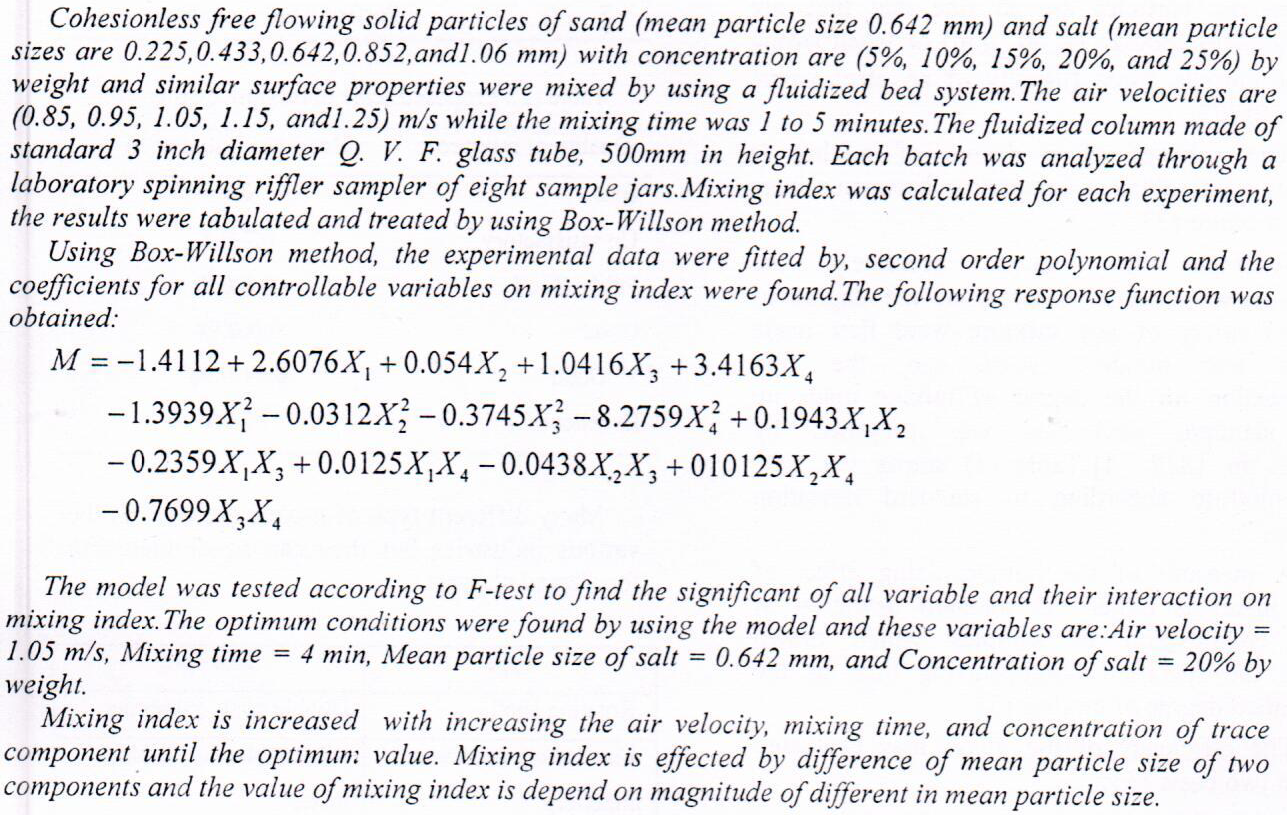
Copper and Zinc powders with different particle sizes were subjected to sieving of range (20-100?m) and He-Ne laser system to determine the particle size . 1wt% from each powders was blended carefully with 99wt% from Iraqi oil . Microscopic examination were carried for all samples to reveal the particle size distribution . XRF intensity measurements were conducted for all suspended samples , and the relation between XRF intensity and the particle size was found .
Staphylococcus aureus is a common pathogenic agent due to its ability to cause various types of infections, ranging from mild skin infections to sever systemic diseases. One of the most virulence factors of this bacterium is its ability to from biofilms on solid surfaces by anchoring the planktonic cells and by producing a protective layer of extra polymeric substances. Biofilm formation is controlled through many genes. The most important ones are icaA and icaD. Dentures are prosthetic devices that are made of different materials to replace lost teeth. The aim of this study is to examine the ability of different types of denture materials to support the biofilm formation of S. aureus at phenotypic level by detecting ba
... Show More (2)
(2)
In the present work, Uranium (238U), Thorium (232Th) and Potassium (40K) specific activity concentration in (Bq/kg) was measured in five different types for wheat flours that are available in the Iraqi markets. The gamma spectrometry method with an NaI (Tl) detector has been used for radiometric measurements. Calculations of radium equivalent activity, annual effective dose equivalent, external hazard index (Hex), internal hazard index (Hin), representing gamma index and gamma dose rate in all flour samples were 17.98132 Bq/kg, 0.0100334, 0.04502, 0.04857, 0.06872, 0.125883 and 8.181244 respectively. It is found that the average of specific activity concentration of wheat flour sam
... Show More (9)
(9)
 (3)
(3)
Steel–concrete–steel (SCS) structural systems have economic and structural advantages over traditional reinforced concrete; thus, they have been widely used. The performance of concrete made from recycled rubber aggregate from scrap tires has been evaluated since the early 1990s. The use of rubberized concrete in structural construction remains necessary because of its high impact resistance, increases ductility, and produces a lightweight concrete; therefore, it adds such important properties to SCS members. In this research, the use of different concrete core materials in SCS was examined. Twelve SCS specimens were subjected to push-out monotonic loading for inspecting their mechanical performance. One specimen was constructed from co
... Show More (34)
(34)
 (32)
(32)
Municipal solid waste is one of the most important environmental problems in the world and is an important source of environmental pollution and contributes significantly to the pollution of the basic environmental elements of soil, water and air. The management of municipal waste in general is a process of monitoring, collection, treatment or recycling if possible or disposal of waste. This term is used for waste produced by some human activities. States provide this process to mitigate the negative effects of waste on the environment, health and appearance of the city. It is possible to find solutions to the problem of solid waste and make it an important source of income and contribute to securing employment oppor
... Show MoreNumerical study is adapted to combine between piezoelectric fan as a turbulent air flow generator and perforated finned heat sinks. A single piezoelectric fan with different tip amplitudes placed eccentrically at the duct entrance. The problem of solid and perforated finned heat sinks is solved and analyzed numerically by using Ansys 17.2 fluent, and solving three dimensional energy and Navier–Stokes equations that set with RNG based k−ε scalable wall function turbulent model. Finite volume algorithm is used to solve both phases of solid and fluid. Calculations are done for three values of piezoelectric fan amplitudes 25 mm, 30 mm, and 40 mm, respectively. Results of this numerical study are compared with previous b
... Show More (1)
(1)
A single step extraction-cleanup procedure using porous membrane-protected micro-solid phase extraction (μ-SPE) in conjunction with liquid chromatography–tandem mass spectrometry for the extraction and determination of aflatoxins (AFs) B1, B2, G1 and G2 from food was successfully developed. After the extraction, AFs were desorbed from the μ-SPE device by ultrasonication using acetonitrile. The optimum extraction conditions were: sorbent material, C8; sorbent mass, 20 mg; extraction time, 90 min; stirring speed, 1000 rpm; sample volume, 10 mL; desorption solvent, acetonitrile; solvent volume, 350 μL and ultrasonication period, 25 min without salt addition. Under the optimum conditions, enrichment factor of 11, 9, 9 and 10 for AFG2, AFG1
... Show More (63)
(63)
 (62)
(62)
Objective: Conventional approaches for disinfection, including spraying and immersion, resulted in only surface disinfection of impressions. As a result, self-disinfecting impression materials incorporated with antimicrobial compounds require more extensive studies. The incorporation of a disinfectant into irreversible hydrocolloid impression materials could eliminate the need for the disinfection step by conventional approaches, including spraying and immersion which only result in surface disinfection of impressions. The study was aimed to investigate the effect of incorporation of hypochlorous acid in irreversible hydrocolloid materials on antimicrobial efficiency, detail reproduction, and dimensional stability. Materials and
... Show More (4)
(4)
Background: to evaluate the effect of different dentifrices on the surface roughness of two composite resins (nanofilled-based and nanoceramic – based composite resins). Materials and methods: Forty specimens (diameter 12 mm and height of 2mm) prepared from different composite resin materials: Z350 (nanofilled composite, and Ceram-X (nanoceramic) .they were subjected to brushing simulation equivalent to the period of 1 year. The groups assessed were a control group brushed with distilled water (G1), Opalescence whitening toothpasteR (G2), Colgate sensitive pro-relief (G3) and Biomed Charcoal Toothpaste (G4). The initial and final roughness of each group was tested by surface roughness tester. The results were statistically analyzed using
... Show More (1)
(1)
